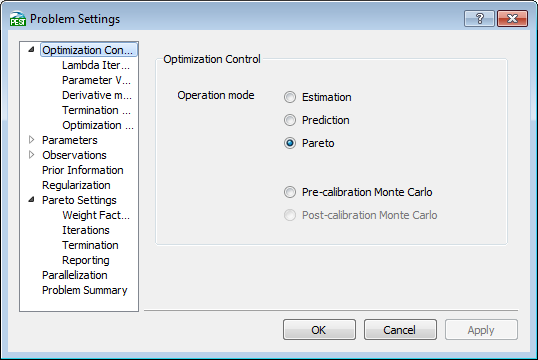Pareto Settings
Preliminaries
- On the Parameters / Groups page, Ensure that each parameter group has a Derivative method set to: always_2, always_3 or always_5.
- If exploration of the trade-off between measurement and regularization objectives is desired, Tikhonov regularization should be enabled and all observations should be organized into one observation group. Relative weighting assigned to objective function components within this overall group should be correct
- If exploration of the predictive uncertainty is desired, the observations should be organised into more that one observation group. One of these groups should contain the prediction observations.
Setting the Optimization Mode
To configure FePEST to run in Pareto Mode:
-
Open the Problem Settings dialogue by clicking on the menu item Edit / Problem Settings.
-
Select the Optimization Control page by clicking on the appropriate node in the tree on the left hand side on the dialogue.
-
Select the Operation mode entitled Pareto.
-
Click on the Apply button: A new tree node Pareto Settings is added to the tree.

Problem Settings dialog: Activating Pareto operation mode.
Pareto Settings
Main Settings Page
Select the main Pareto Settings page by clicking on the appropriate tree node in the Problem Settings dialogue.
Here the user must enter the name of an observation group which will define the predictive objective function (if exploring predictive uncertainty) or the measurement objective function (if exploring the trade-off between trade-off between the measurement and regularization objectives).
FePEST labels the observation group selection depending on the number of observation groups and whether or not Tikhonov regularization has been enabled:


Observation group for the Pareto run.
This group must possess at least one observation of non-zero weight. PEST applies a changing multiplier to the weights associated with all observations belonging to this group as a means of exploring the Pareto front.
Weight Factors Settings Page
The input field labelled PARETO_WTFAC_START is the initial weight factor that PEST should apply to members or the observation group. This defines the point at which PEST commences its journey along the Pareto front. Normally this variable should be set to zero.
PARETO_WTFAC_FIN is the final weight factor that PEST must apply to the selected observation group. A value between 1.0 and 2.0 is suggested.
The NUM_WTFAC_INC variable is the number of increments by which PEST should vary the weight factor in raising it from PARETO_WTFAC_START to PARETO_WTFAC_FIN. Thus, for example, if NUM_WTFAC_INC is supplied as 10, PEST will employ 11 (but possibly less - see below) weight factors in at least 10 (but possibly more) successive optimization iterations in exploring the Pareto front. The first weight factor will be PARETO_WTFAC_START, the second will be PARETO_WEIGHT_START plus a number equal to a tenth of the difference between PARETO_WTFAC_START and PARETO_WTFAC_FIN, etc.
Iterations Settings Page
These variables on this page dictate how many optimization iterations PEST should devote to minimizing the total objective function (i.e. calibration plus prediction objective functions) based on each prediction weight factor that it employs in its journey along the Pareto front. NUM_ITER_START pertains to the first weight factor used (namely PARETO_WTFAC_START); NUM_ITER_START can be zero or greater. NUM_ITER_FIN pertains to the final predictive weight factor used (namely PARETO_WTFAC_FIN); this can also be zero or greater. NUM_ITER_GEN is employed for weight factors in between. This must be one or greater.
Termination Page
If the termination is checked, then traversal of the Pareto front can terminate prior to using a weight factor of PARETO_WTFAC_FIN. In this case termination of PEST execution will occur if an observation rises above, or falls below, a certain threshold, and stays above or below that threshold over a certain number of iterations.
Reporting Page
On this page, observations may be selected so that their values are recorded in the Pareto result files.









